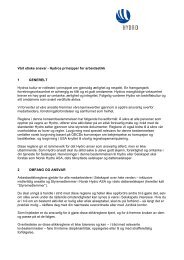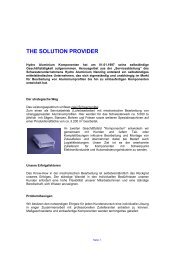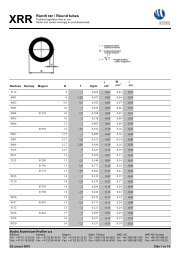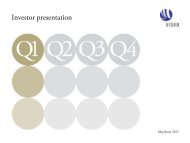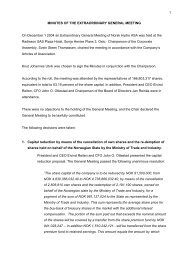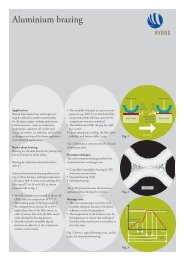Hydro Annual Report 2011b
Hydro Annual Report 2011b
Hydro Annual Report 2011b
Create successful ePaper yourself
Turn your PDF publications into a flip-book with our unique Google optimized e-Paper software.
F16<br />
FINANCIAL STATEMENTS<br />
Note 3 - Basis of presentation and measurement of fair value<br />
Embedded derivatives<br />
<strong>Hydro</strong> measures embedded derivatives that are separated (i.e. bifurcated) from the host contract by comparing the forward<br />
curve at contract inception to the forward curve as of the balance sheet date. Changes in the present value of the cash flows<br />
related to the embedded derivative are recognized in the balance sheet and in the income statement. Forward curves are<br />
established as described above under Derivatives. For contracts that contain embedded caps or floors, Asian option valuation<br />
models are used.<br />
Note 4 - Critical accounting judgment and key sources of estimation uncertainty<br />
The application of accounting policies require that management make estimates and judgments in determining certain<br />
revenues, expenses, assets, and liabilities. The following accounting policies represent areas that are considered more critical,<br />
involving a higher degree of judgment and complexity.<br />
Impairment of non-current assets<br />
IAS 36 requires that <strong>Hydro</strong> assess conditions that could cause an asset to become impaired and to test recoverability of<br />
potentially impaired assets. These conditions include significant decrease in the market value of the asset, changes in <strong>Hydro</strong>'s<br />
business plan for the asset or a significant adverse change in the business and legal climate. Each Cash Generating Unit (CGU)<br />
or individual asset is reviewed for impairment indicators. Most of <strong>Hydro</strong>'s assets are assigned to CGUs, which is the lowest<br />
level where largely independent cash flows are deemed to exist. The identification of CGUs involves judgment, including<br />
assessment of where active markets exist, and the level of interdependency of cash inflows. For <strong>Hydro</strong>, the CGU is usually the<br />
individual plant, unless the asset or asset group is an integral part of a value chain where no independent prices for the<br />
intermediate products exist, a group of plants is combined and managed to serve a common market, or where circumstances<br />
otherwise indicate significant interdependencies.<br />
If a loss in value is indicated, the recoverable amount is estimated as the higher of the asset or CGU's fair value less cost to sell,<br />
or its value in use. Directly observable market prices rarely exist for our assets, however, fair value may be estimated based on<br />
recent transactions on comparable assets, bids or other discussions of potential transactions involving the asset, or internal<br />
models used by <strong>Hydro</strong> for transactions involving the same type of assets. Calculation of value in use is a discounted cash flow<br />
calculation based on continued use of the assets in its present condition, excluding potential exploitation of improvement or<br />
expansion potential.<br />
Determination of the recoverable amount involves management estimates on highly uncertain matters, such as commodity<br />
prices and their impact on markets and prices for upgraded products, development in demand, inflation and operating<br />
expenses, and technology changes. We use internal business plans, quoted forward prices and our best estimate of commodity<br />
prices, currency rates, discount rates and other relevant information. In periods when observed prices in the market are<br />
considered inconsistent because they over time render either exceptionally positive cash flows or consistently negative cash flows<br />
for a majority of market participants over time, adjustments in the mid to long term prices are made in order to reflect <strong>Hydro</strong>'s<br />
current expectations of net cash flows. A detailed forecast is developed for a period of three to five years with projections<br />
thereafter. <strong>Hydro</strong> does not include a general growth factor above inflation to volumes or cash flows for the purpose of<br />
impairment tests, however, market recovery towards previously observed levels is considered. Estimated cash flows are<br />
discounted with a risk adjusted discount rate derived as the weighted average cost of capital (WACC) for a similar business in<br />
the same business environment. For <strong>Hydro</strong>'s businesses the pre tax nominal discount rate is estimated at between 9 and 12<br />
percent (2010: 8.75-13.5 percent). The variance in discount rates mainly results from differences in risk free interest rates and<br />
tax levels in different regions. For further information about impairment tests, see note 13 Impairment of non-current assets.<br />
Financial instruments<br />
Certain commodity contracts are deemed to be financial instruments under IAS 39 or to contain embedded derivatives which<br />
are required to be recognized at fair value, with subsequent changes in fair value impacting the income statement. Determining<br />
whether contracts qualify as financial instruments at fair value involves evaluation of markets, <strong>Hydro</strong>'s use of those instruments<br />
and historic or planned use of physically delivered products under such contracts. Determining whether embedded derivatives<br />
are required to be separated and accounted for at fair value involve assessing price correlations and normal market pricing<br />
mechanisms for relevant products and market places. Where no directly observable market prices exist, fair value is estimated<br />
through valuation models which rely on internal assumptions as well as observable market information such as forward curves,<br />
yield curves and interest rates. Market stability impacts the reliability of observed prices and other market information, and<br />
consequently, the extent of judgment necessary to estimate appropriate market prices for valuation purposes. Volatility also










